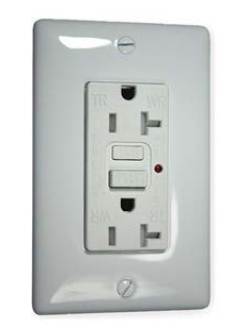Ground Fault Circuit Interrupters
 Electrical Safety Foundation International (ESFI), http://www.esfi.org/
Electrical Safety Foundation International (ESFI), http://www.esfi.org/
Even today’s modern electrical devices are subject to the basic principles of electricity. One of the most important being – water and electricity don’t mix! Luckily, there is a technology available to help protect you from this shocking hazard. In fact, Ground Fault Circuit Interrupters have been providing this type of protection to consumers since the early 1970s.
What is a ground fault?
A ground fault is an unintentional electrical path between a power source and a grounded surface. These leakage currents usually occur when an electrical appliance is damaged or the electrical parts are wet, causing electrical current to flow outside of the circuit conductors. If your body provides a path to the ground for this current, you could be burned, severely shocked, or electrocuted.
What are ground fault circuit interrupters, or GFCIs?
GFCIs are electrical safety devices that are designed to protect people from electric shock and electrocution. Typically, GFCIs are installed in areas where water and electricity are in close proximity, such as the bathroom, kitchen, garage, basement, and outdoors. They are especially useful for cord-connected appliances and equipment used outdoors or near water.
How do GFCIs work?
GFCIs prevent deadly shock by quickly shutting off power to the circuit if the electricity flowing into the circuit differs by even a slight amount from that returning, indicating a loss of current.
Are they effective?
Since the 1970s, GFCIs have saved thousands of lives and have helped cut the number of home electrocutions in half. Since first including a home GFCI requirement in 1971, the National Electrical Code (NEC) has continually expanded the requirements to include additional locations. The NEC currently requires that GFCIs be used in all kitchens, bathrooms, garages, basements, crawlspaces, and outdoors.
Is it cost effective to switch to GFCIs?
GFCI outlets are generally fairly inexpensive, starting under $15.
Can I install them myself?
GFCIs should only be installed by a licensed, qualified electrician. Portable GFCIs require no tools to install and provide flexibility in using receptacles that are not GFCI-protected. They are commonly used outdoors.
How to Test Your GFCIs
Be sure to test your GFCIs once a month to make sure they are working properly.
1. Push the “reset” button on the GFCI to prepare the outlet for testing.
2. Plug an ordinary nightlight into the GFCI and turn it ON. The light should now be on.
3. Push the “test” button of the GFCI. The nightlight should turn OFF.
4. Push the “reset” button again. The nightlight should now go ON again. If the nightlight does not turn off when the “test” button is pushed, then the GFCI is not properly protecting you from shock or electrocution. It may have been improperly wired or damaged. Contact a licensed, qualified electrician to check the GFCI and correct the problem.
Click here for a downloadable flyer.



